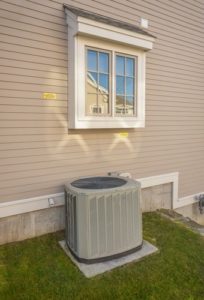If you’re thinking about adding central air conditioning to an existing house, statistics show you’ve got a lot of company. In fact, while air conditioning was installed in just over 60 percent of homes as recently as the early 1990s, today about 87 percent of existing U.S. residences now enjoy some form of A/C. Here in the East, more than half of those have either central air conditioning or some combination of central and window units. In new home construction, it’s not even close: Nationally, more than 90 percent of new houses are now built with central air already installed. Fortunately, our AC Repair and installation technicians can handled any kind of AC unit.
Window Downsides
 There are solid reasons why adding central air conditioning is the most viable, whole-house option for bringing cool comfort to an existing home. Window units address comfort issues in single rooms or small enclosed areas only. In the midst of a hot, mid-Atlantic summer, residents find themselves increasingly restricted to these “islands” of coolness while the rest of the uncooled house remains stuck in the uncomfortable zone.
There are solid reasons why adding central air conditioning is the most viable, whole-house option for bringing cool comfort to an existing home. Window units address comfort issues in single rooms or small enclosed areas only. In the midst of a hot, mid-Atlantic summer, residents find themselves increasingly restricted to these “islands” of coolness while the rest of the uncooled house remains stuck in the uncomfortable zone.
In addition, cooling individual rooms with multiple window units is more energy-expensive than running a single central air conditioner, particularly when you consider the substantial advances in efficiency available from new central systems today.
Aesthetics is another a drawback of window units. They’re bulky, block the outdoor view and reduce available light. After all, who would want a view of Baltimore’s skyline at night or Northern Virginia’s idyllic countryside during the day blocked by a window unit?
Living with a noisy compressor and fan mounted in a window unit only a few feet from where you’re sitting or sleeping is never as quiet as a central system, where the loud components are exiled to remote locations like the attic and backyard.
Breathe Easier
Indoor air quality is another upside to adding central air conditioning. In addition to conveying coolness to every room, the A/C functions as a whole-house filtration system as well. The blower in a central air system turns over the entire volume of household air multiple times every day. As household air circulates through the ductwork, the system filter continuously removes airborne particulates including dust, allergens and other irritants to safeguard the air quality in your entire home. A furnace blower that only runs half the year or the downsized air filter in a window unit can’t match the air quality improvements available from adding central air conditioning and using quality air filters.
Comfort Components
A central air conditioning system incorporates a number of components, most of which aren’t pre-existing in a home. Here are the major extra items that will need to be installed:
- Indoor air handler – Comprised of the central A/C evaporator coil and blower, this unit is typically mounted in the attic or a dedicated HVAC closet in retrofit scenarios. Alternatively, if the home has existing forced-air heating, the central A/C system may be grafted onto the heating system by installing the evaporator coil in the furnace plenum and utilizing the furnace blower for air circulation or replacing it with a more suitable model.
- Outdoor condenser unit – This vital component comprises the A/C compressor, condenser coil and condenser fan. In split-system central air, the most common configuration for residential cooling, the outdoor unit is located just behind or to the side of the house and connected to the indoor air handler by two insulated lines that circulate refrigerant.
Ductwork Matters
The good news is that you may have it already. The bad news is that if you don’t, you may be hesitant about adding central air conditioning. Visions of walls torn open to install new ducts and a lengthy, disruptive construction project can be daunting. The reality, however, is actually quite different:
- As mentioned above, if you have a forced-air furnace, you already have ductwork installed that may be suitable for cooling purposes. In many cases, a central A/C system can be connected to existing ducts without additions. A qualified HVAC contractor can do the calculations necessary to determine whether the present furnace blower can handle the airflow required to cool the home or whether upgrading to a more powerful but often more energy-efficient blower is advisable.
- When ductwork installation is needed for adding central air conditioning, extensive renovation like opening wall voids is actually seldom required. In a single-level home, the air handler unit is installed in the attic and ductwork is routed between attic joists to the ceiling of each individual room, where supply and return vents are created through small openings in the ceiling. In a split-level home, ductwork is routed through closets, passing through the closet ceiling and floor down to the lower level. Most of the cuts required to install today’s downsized ducts are small holes—the large, boxy ducts you may be imagining are mostly a thing of the past.
Before Adding Central Air Conditioning
A professional HVAC contractor will do the necessary preliminary work to ensure that adding central air conditioning delivers the cool comfort and efficiency you’re expecting. Every central system installation should include these standard prerequisites.
Sizing
The new A/C unit must be a correct match for the specific cooling requirements of the home. Proper sizing relates not to the physical size of the unit, but to its capacity to keep your home cool. In A/C terms, “capacity” relates to the amount of BTUs of heat energy the unit can extract from the interior of the house every hour.
For proper results, A/C cooling capacity must be commensurate with the amount of heat gain the house experiences during the same time span. A qualified HVAC technician will perform a cooling load calculation to determine the A/C capacity required to keep the house comfortable on the typical hot day. Getting sizing right is vital to satisfactory results when adding central air conditioning to an existing house.
An oversized air conditioner with too much capacity for the house cycles on and off rapidly, causing noticeable temperature swings as well as failing to extract humidity effectively. You’re stuck with that poor performance for as long as the air conditioner is installed. An undersized unit, meanwhile, runs almost continuously as it struggles to meet thermostat settings, wasting energy and raising operating costs.
Efficiency
Central A/C efficiency is represented by a unit’s seasonal energy efficiency ratio (SEER). It’s a ratio that expresses the BTUs of heat removed from the home in comparison to the amount of electricity consumed. In Maryland, the new required minimum SEER is 14. When adding central air conditioning, you can choose from systems with SEER ratings as high as 20 or more. Though high-efficiency units lower operating costs by reducing energy consumption, they also come at a substantially higher purchase price. Your HVAC contractor can advise you on striking the right balance between upfront costs and long-term energy savings.
Insulation and Air Sealing
Cooling performance and efficiency of an air conditioner are directly related to the integrity of the structure. Homes built more than 20 years ago were often constructed to less efficient standards. Frequently, these houses allow an unacceptable amount of air infiltration through cracks and gaps in the structure. In addition, they’re usually underinsulated by today’s higher standards, particularly in the attic.
An HVAC contractor can conduct a blower door test to quantify the exact amount of air leakage and pinpoint the location of leaks. In addition, he’ll assess the amount and quality of insulation in the attic and inside walls, and may suggest options to upgrade that level to meet current Department of Energy (DOE) standards.
Ductwork
Residential ducts are notoriously leaky as they age. Where pre-existing furnace ductwork is to be utilized for cooling, sealing and/or other duct maintenance may be necessary before connecting the new central air conditioner.
In many locales, local building codes require pre-upgrade testing and sealing. Your HVAC contractor can conduct a duct pressurization test to determine the extent of leakage relative to the amount of airflow conveyed through the ducts. Duct sealing generally requires leak-proofing joints with mastic and metallic tape, then securing each joint connection with metal screws. Where pinhole leaks are an issue, spray aerosol sealant can be injected into the ducts.
For more information on adding central air conditioning to your home, check out Griffith Energy Service’s cooling solutions or call 888-474-3391.
Image Provided by Shutterstock.com



